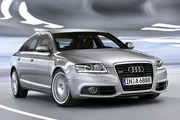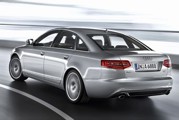Review
For what is being billed as a minor mid-life refresh on the surface, Audi has been very busy working under the skin of the new A6.
Apart from some new lights and a couple of bits of trim, there’s revised quattro four-wheel drive hardware which has been retuned for more dynamic driving, upgraded technology to host the third-generation MMI system, and a supercharged V6 petrol engine to bring better performance and more efficiency.
All of which is fine and dandy, but the real star of the new A6 range is the entry-level model – the 2.0 TDIe.
The small ‘e’ denotes it is an economy model, tuned for performance on the balance sheet and not on the road.
This new 2.0-litre common rail diesel engine delivers 136bhp (down from the old model’s 140), yet increases average fuel economy from 46.3 to 53.3mpg (giving the new model an extra 100 miles range).
CO2 emissions drop from 159 to 139g/km, putting this Audi in a good position in terms of benefit-in-kind taxation and the new rules on capital allowances.
Aside from a slight retuning of the engine, the TDIe model also uses some hidden tweaks to make it more efficient.
For a start, it rides 20mm lower than other A6s which, combined with some aerodynamic tweaks, make the TDIe more slippery through the air.
Longer transmission ratios, an alternator which regenerates energy when the car is coasting, and a special power steering system complete the fuel saving theme.
None of which you notice when you’re driving along. Instead you sit in the superbly built cabin and make decent, comfortable progress while sipping fuel at a parsimonious rate.
Despite the A6’s size and weight, it is not hindered by having a 2.0-litre engine delivering just 136bhp.
In fact it feels fairly sprightly – or at least it does until you get in a BMW 520d and realise what a 2.0-litre diesel can offer (177bhp and better fuel economy/lower emissions).
The BMW is the exception though, rather than the norm.
In everyday driving conditions the A6 TDIe is a more than adequate companion.
The steering feel is light to the point of over-assistance, the six-speed manual gearbox shifts slickly, the ride quality is on the firm side but the pay-off is four-square handling in corners.
The A6 comes into its own on motorways and fast A-roads, where its planted feel and low-rev nature thanks to the taller gear ratios make it a very relaxing cruising companion.
On twistier roads the A6 suffers, and isn’t able to match the dynamic prowess of the 520d.
However, in every other respect Audi has caught up with its executive nemesis.
We like:
Beautifully built
Successful facelift
BIK bill
Running costs
We don't like:
Performance
Highest SMR costs
THREE RIVALS TO CONSIDER
BMW 520d SE
Mercedes-Benz E220 CDI Executive SE
Volvo S80 2.0D SE
P11D PRICE
All the models are in SE specification, with the exception of the Mercedes-Benz which is a special edition aimed at the corporate market. It is cheaper than the entry Classic trim and comes with man-made ‘leather’ seats, satellite navigation and Bluetooth telephony.
S80: £24,145
A6: £25,925
520d: £27,290
E220: £28,795
EMISSIONS AND TAX RATES
The Audi puts its front-end price advantage to good use, resulting in a cheaper BIK tax bill. It will cost a 40% taxpayer £155 a month in company car tax, compared to a £164-a-month bill for the BMW. The Volvo will cost £169 a month and the E-Class £221 a month.
520d: 136g/km/18%
A6: 139g/km/18%
S80: 151g/km/21%
E220: 160g/km/23%
SMR COST
With 16-inch wheels, the Mercedes-Benz is the cheapest in SMR costs. The rest all have larger 17-inch wheels which means higher tyre costs. The German trio all have variable servicing intervals, which mean potentially fewer services than the set 18,000-mile service intervals on the Volvo.
ppm/60k total
E220: 4.27/£2,562
520d: 4.82/£2,892
S80: 4.87/£2,922
A6: 5.60/£3,360
FUEL COST
The BMW returns a claimed 55.4mpg on the combined cycle, which represents a diesel spend of £6,100 over 60,000 miles. The Audi is slightly behind on 53.3mpg and will cost £240 more in fuel over that period. The Volvo returns a claimed 49.6mpg and the E220 46.3mpg.
ppm/60k total
520d: 10.22/£6,132
A6: 10.62/£6,372
S80: 11.41/£6,846
E220: 12.23/£7,338
DEPRECIATION COST
The Audi will be worth the most money in three years and 60,000 miles – £9,500 (or 37% of cost new). This helps the A6 to a 1.7 pence-per-mile advantage. The BMW will be worth £8,875 (33%), the E220 £8,850 (31%) and the Volvo just £5,650 (23%).
ppm/60k total
A6: 27.25/£16,350
S80: 28.99/£17,394
520d: 30.10/£18,060
E220: 32.49/£19,494
WHOLELIFE COST
The Audi opens up a significant advantage, costing £1,000 less to run than the BMW over three years and 60,000 miles – it is competitive on fuel costs and puts in a class-leading performance in terms of retaining value. The Mercedes-Benz is well off the pace in this sector.
ppm/60k total
A6: 43.37/£26,022
520d: 45.14/£27,084
S80: 45.27/£27,162
E220: 48.99/£29,394
VERDICT
The Mercedes-Benz is the first to be discounted.
Despite being a special model tailored for corporate buyers, it is outclassed in both running costs and driver benefit-in-kind taxation levels.
The Volvo also goes, but it puts up a far better fight than the E-Class.
At this level, the Volvo badge still hasn’t quite got the cachet of the German marques, which drivers in this country love.
So it comes down, as is the norm, to a straight fight between Audi and BMW.
The A6 offers drivers the lowest benefit-in-kind bills and is also the cheapest for a company to run.
Despite not being able to rise to the dynamic challenge of the BMW, the Audi’s cost proposition wins through.
WINNER: Audi A6 2.0 TDIe SE
















Login to comment
Comments
No comments have been made yet.